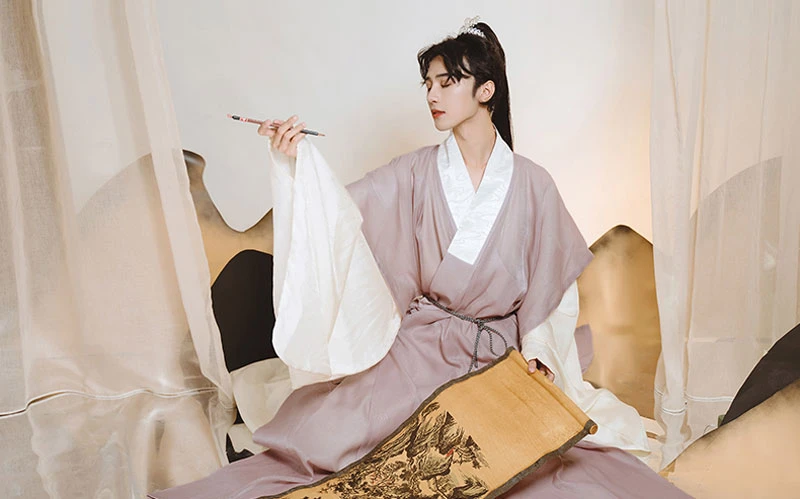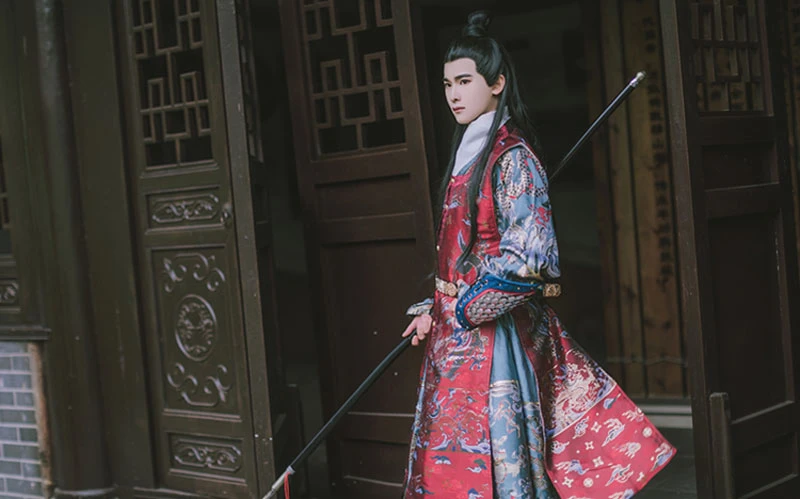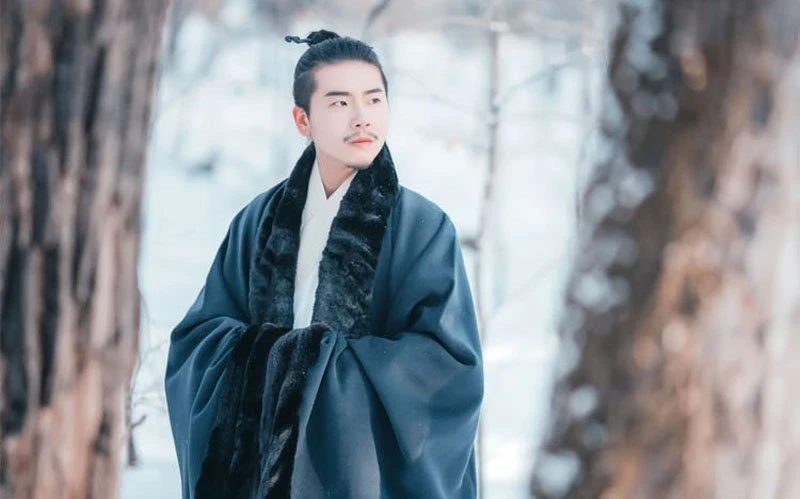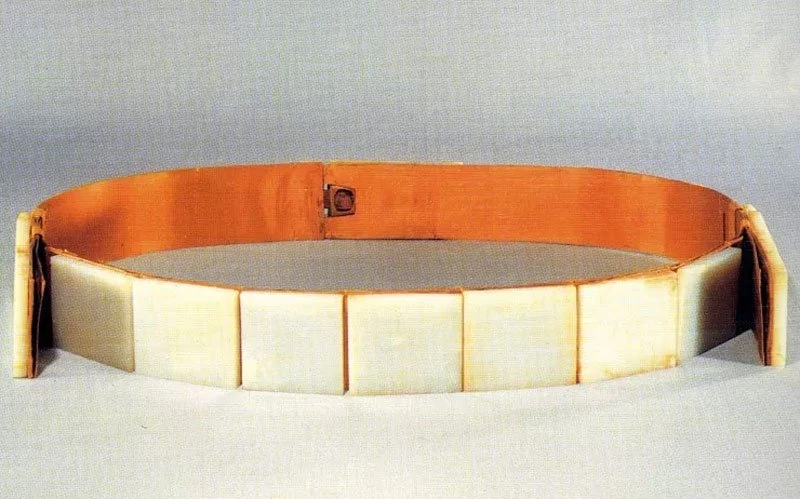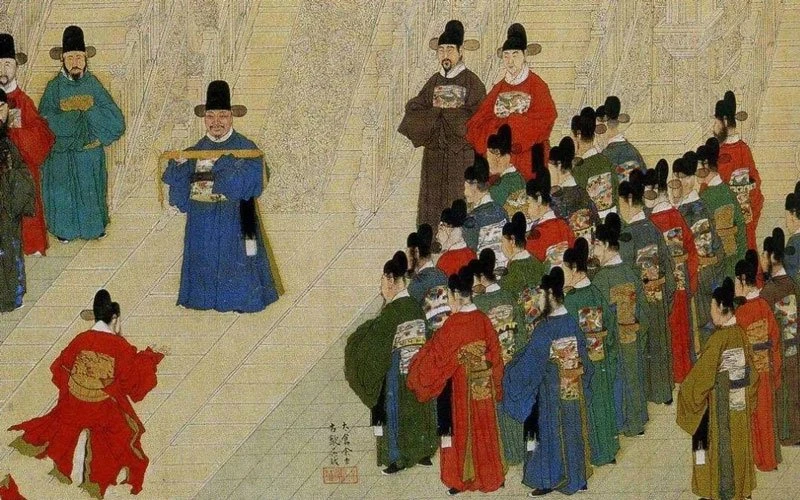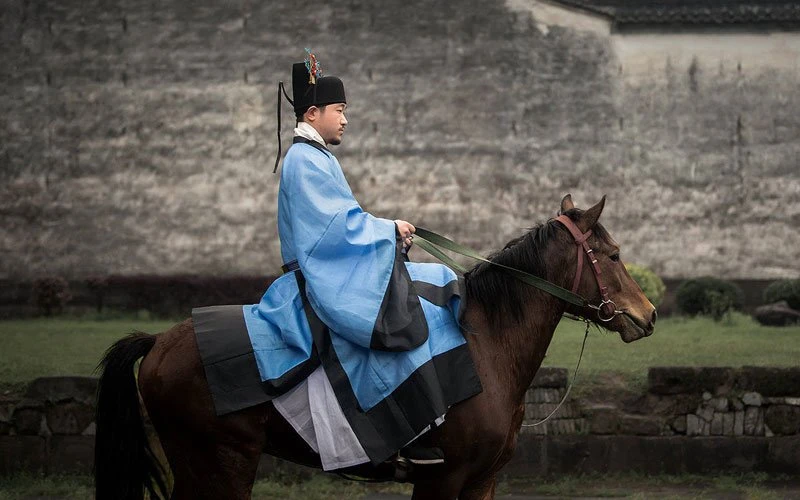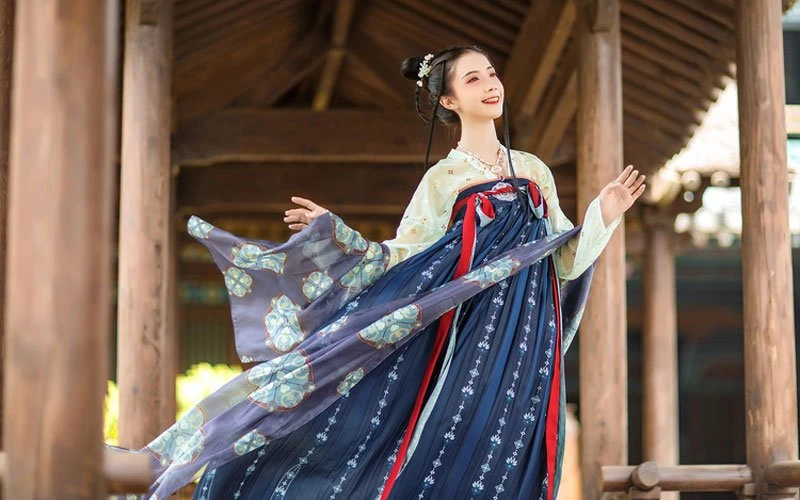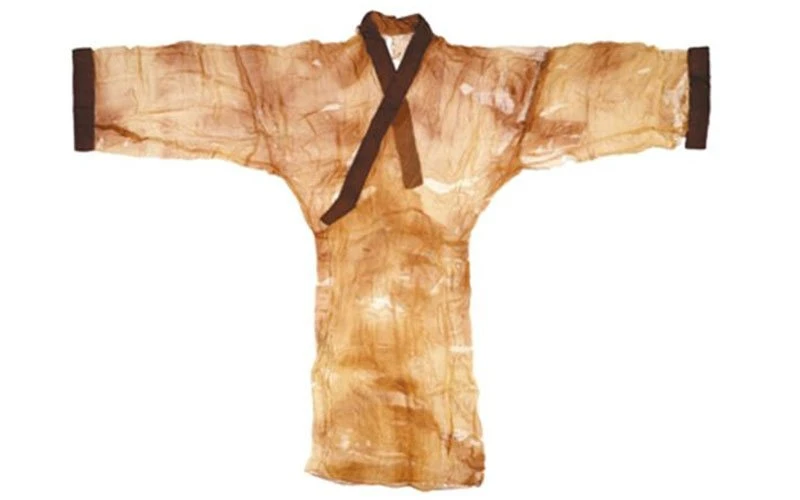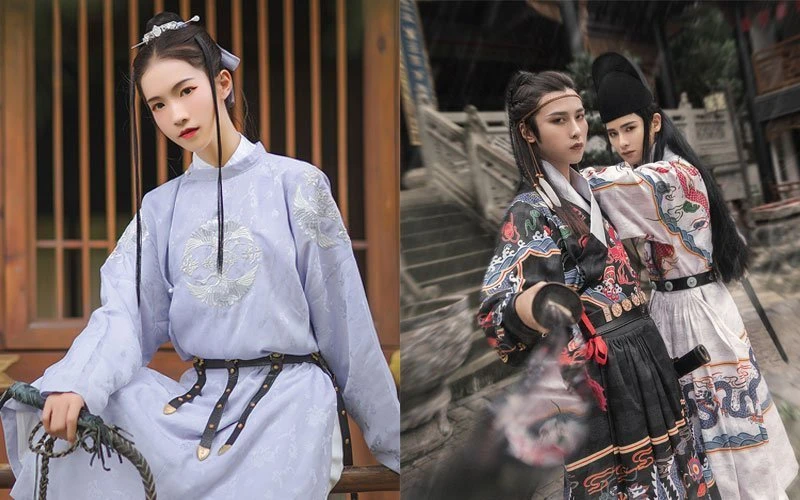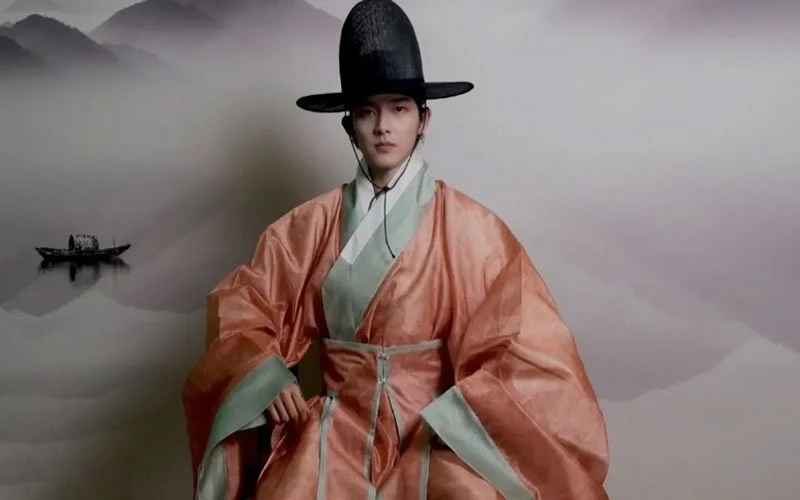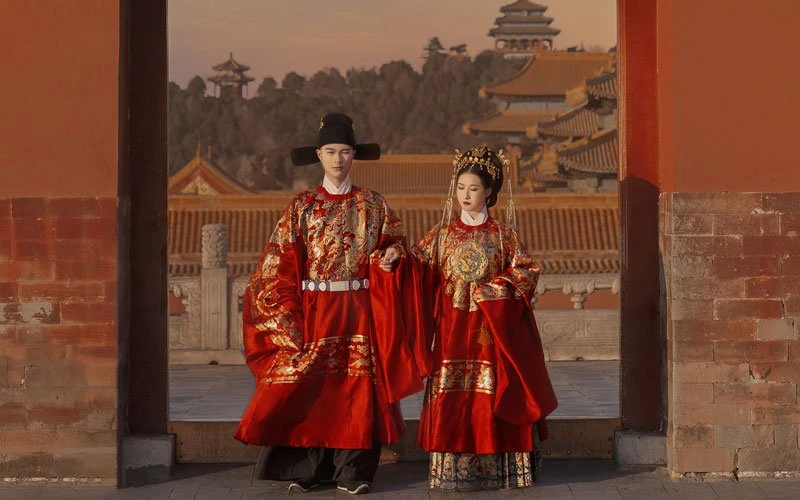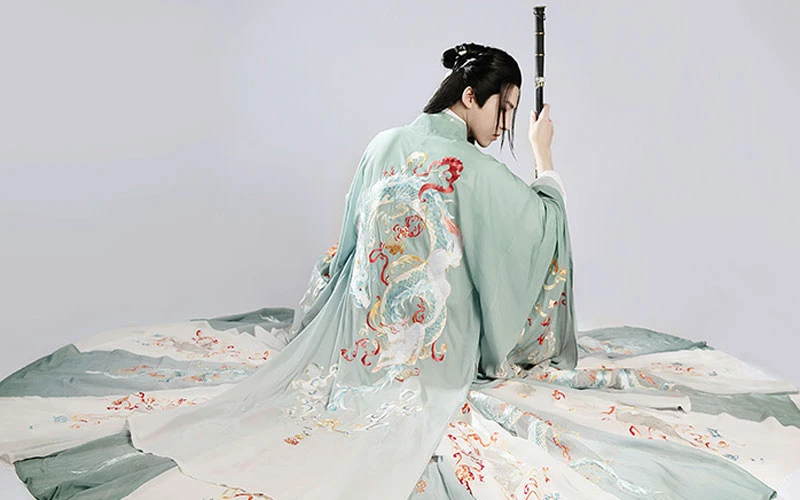
Various Types of Costumes in Hanfu
Introduction to the different styles of Hanfu, with historical background and picture presentation.
Total 39 Articles
Topics: 4
-
What is Da Hu - Chinese Traditional Male Clothing
What is Da Hu? Da Hu(褡护, dā hù), also known as "搭护", which was a type of Bianfu(便服, casual wear) in the Ming Dynasty. The Tong Ya says: "Da Hu is a shirt with bald sleeves", which means sleeveless, indicating that the Da Hu was a long garment with short sleeves or no sleeves, and had a certain origin with the Banbi of the Tang and Song dynasties. The "Juyi Record" records that: "The name of the Da Hu, or along with the Yuan dynasty, its style is not the Yuan dynasty Da Hu, when it is a slightly longer than the Gua (褂), a short-sleeved clothes." The basic form of Da Hu is cross collar, wrapping the right side before the left (交领右衽), with white collar protector, short sleeves or no sleeves, slit on both sides of the body, and the slit is connected with the outer or inner hem. In the Ming Dynasty, the Da Hu was a kind of half-sleeved dress with a hem outside, which was part of the dres's system of Ming officials. How to wear the Da Hu? What to wear inside the Da Hu? Da Hu early is often used as a jacket,…...Ling
- 1.4k
- 2
-
Gorgeous Zhaojia - Traditional Chinese Outfit for Males
Today, Hanfu Culture Society will introduce Zhaojia (罩甲) to you, a very handsome traditional Chinese outfit for males. [Structure and History] Zhaojia, square or round collar, lapels, metal or cloth buttons, sleeveless or short sleeves, slits on both sides. This structure is very convenient for horseback riding and movement, and it is mostly used as an outer garment on top of the Tieli (贴里) and Yisan (曳撒). Zhaojia first originated in the Hongwu period of the Ming Dynasty, and it can be found through ancient painting materials that Zhaojia was generally used as a military uniform in ancient times, and was very common during the emperor's hunting trips and in ceremonial processions. Most of the Zhaojia used by the royal family were decorated with patterns such as woven gold dragons in Yunjian (云肩) and Xilan (膝襕), the famous Asian Art Museum of San Francisco has a piece of Zhaojia (from the twenty-third year of the Wanli) in its collection, which is decorated with a dragon motif and a prominent gold "卍" pattern. The bottom of this Zhaojia is decorated with dragon, colorful clouds, and mountain and sea patterns, which is very gorgeous. In addition, Zhaojia still popular in the folk,…...Ling
- 1.3k
- 3
-
Traditional Chinese Winter Clothing for Male - Changyi
As you may know, the Ming-style Hanfu is perfect for the winter, because it's wide enough to fit a lot of warm clothes. So, what other Chinese winter clothing can you think of for winter wear besides the Ming-style? Maybe Changyi is a good choice, follow along with Hanfu Culture Society to learn more about this Hanfu style that will bring you warmth in the cold winter. [Structure and History] Changyi (氅衣, chǎng yī), also known as Hechang (鹤氅) or Dachang (大氅). Straight collar, parallel opening, large sleeves, a pair of laces on the front lapel to tie the knot, the length of the coat is up to the calf or ankle. The body is mostly light in color, but can be decorated with ornate patterns, with dark edges on the collar and sleeve edges, and usually with no slits on the sides, but can be made with slits or pleats. As one of the categories of traditional Chinese winter clothing for male, Changyi has appeared in traditional Chinese literature with high frequency since the Eastern Jin Dynasty. However, the actual form of the Changyi varies greatly from one period to another. The earliest recorded appearance of the Changyi as…...Ling
- 3.6k
- 1
-
The Most Classic Hanfu of All Time
In the process of evolution, there are dozens or even hundreds of styles of Chinese clothes. This article mainly introduces the most classical styles of Chinese Hanfu clothes. Women's clothing Suit Ruqun(襦裙) Ruqun is a kind of hanfu, also call: Shanqun (衫裙), short clothes worn on the upper body, call "Ru", and the dress of the lower body, call "Qun", together call "Ruqun". It is a typical "Shangyi Xiachang(top clothes and underdress) " form. Ruqun has an obvious feature: short top and long dress. The Ruqun appeared in the Warring States Period, Ruqun was worn by ordinary people(female) until the end of the Ming and Qing Dynasties. Jiaoling Ruqun/ Shanqun(交领襦裙/衫裙) Jiaoling Ruqun is a kind of Ruqun, the main feature is: the top collar is cross. It is quite common in the Song Dynasty. Wearing method: First: Wear top clothes, Align the collar of the top clothes; Tie a knot in right Jin(襟, the chest part of the top); Tie a knot in left Jin. Second: tie up the dress, Put the dress in front of you, wrap the skirt behind you; Two sides of the dress overlap behind; Folding outwards the pressing on the inner layer of dress;…...Lin
- 22.3k
- 9
-
History of Hanfu Sash & Belt Ornament in Ancient China
In the ancient Chinese costume system, Hanfu sash and belt ornaments played a very important role, not only as a means of securing and decorating the garment, but also as a symbol of the wearer's status. In ancient times, officials wore Chaofu (朝服) when going to Shangchao (上朝). The Chaofu was the ancient official's uniform for political discussions, one of the important functions of Chaofu in ancient China was to distinguish between the ranks of superior and inferior through clothing. This distinction was mainly made through the three aspects of the Guan (冠, headwear), the color/Zhangwen (章纹) of the garment, and the belt ornaments. The belt ornaments on Chaofu, specifically the belt and the various types of pendant hanging from it, are mainly of the following types: jade pendants, Bixi (蔽膝), Yinshou (印绶), and Yufu/Yudai (鱼符/鱼袋). In ancient Chinese Chaofu, belt ornaments were a very important part, especially for men, as they were almost the only ornaments they wore and were important identity markers. The role of the belt ornament in expressing the wearer's rank was clearly and straightforwardly defined in the costume system during the Zhou dynasty, and was later enriched and refined through the ages. Hanfu Belt for…...Ling
- 5.5k
- 3
-
The Development of Chaofu in Ancient China
We often see in Chinese TV dramas or movies scenes of the emperor and his ministers discussing political affairs together (called Shangchao, 上朝), with the ministers standing or kneeling opposite the emperor in order of rank, dressed in tidy clothes (Chaofu). So, what is so special about the ministers' clothing? And are the different eras of Chaofu the same? What is the Chaofu? Name: Chaofu (朝服, cháo fú) Alias: Jufu (具服) Function: used at major ceremonies Succession and change: from Zhou to Ming dynasties Before the Zhou Dynasty, Chinese clothing was mainly made in one form, the upper Yi (衣) and the lower Chang (裳) system. The Book of Rites - Yuzao (礼记·玉藻, a chapter describing the ritual) recorded that "Chao Xuanduan (玄端), Xi Shenyi (深衣)", meaning that ministers were required to wear Xuanduan in the morning to attend the Shangchao, while worn Shenyi at home in the evening. The style and development of Chaofu in different dynasties The earliest Chaofu - Pibian Fu Judging from the literature, there were Chaofu as early as in the Zhou Dynasty. The first Chaofu was the Pibian Fu (皮弁服, pí biàn fú), which was made of fine white cloth, and the Yi and…...Ling
- 2.2k
- 2
-
Chinese Traditional Costume - Lanshan for Scholars
Have you've ever wondered what an ancient Chinese scholarly person's costume looked like? In this issue, let's follow Hanfu Culture Society and take a look at one of the Chinese traditional costumes, Lanshan (襕衫, lán shān), a Hanfu costume made especially for scholars. [Structure and History] In the history of ancient Chinese traditional costume, there is a kind of long garment that is cut in one piece at the top and bottom (Tongcai, 通裁) and has a Hanglan (横襕, a seam at the Lanshan's knee) at the hem, which is called "Lanshan". Lanshan is based on the ancient Shenyi Zhi (深衣制), with the Shenyi waistline moved down to the hem, and Henglan added near the knee. The system of the upper Yi and lower Chang was followed in ancient times, and the ritual system was made to symbolize the ancient people's respect for the world and the construction of order. Lanshan began to appear in the Northern dynasty and developed and became more standardized in the Tang dynasty. During the Tang Dynasty, it absorbed the northern dynasty costume system and changed the collar shape from cross collar to round collar and the sleeve style from big sleeves to narrow sleeves.…...Ling
- 2.3k
- 1
-
History of Chinese Traditional Hanfu Shawl: Pibo
Pibo (披帛, pī bó), traditional Hanfu shawl, made from light fabric silk, although now the Hanfu enthusiasts accustomed to call it Pibo, but the name "Pibo" actually appeared later, about the late Tang Dynasty, more often it is called Pei (帔, pèi). In earlier Chinese dramas, Pei was once the symbol of "Chinese ancient costume" with its elegant and beautiful features. In the wardrobe of ancient women, Pei has always been very distinctive and not to be ignored part, wrapped between the arms or draped over the shoulders and neck. Also in Chinese wedding customs, there is "Fengguan Xiapei (凤冠霞帔)", different eras of Pei also have different styles. So how has Pei changed over its long history, and what role has it played? Follow along with Dongfang Zhuangdao to find out more. Traditional Hanfu Shawl Pei before the Song Dynasty Pei, a long silk shawl worn by women in ancient times, is thought to have originated during the Qin and Han dynasties, the more accepted theory is that it was influenced by Buddhism and Metaphysics and originated from the Dajin (搭巾) worn by figures in statues. Since the beginning of the Northern and Southern Dynasties, in the context of ethnic…...Ling
- 4k
- 2
-
History of Chinese Silk Robe & Han Dynasty Textile Industry
Silk is one of the symbols of Chinese civilization, China due to the abundance of silk, has been named the "Silk Country" known, the use of silk is also with the development of the times are also changing, from the initial production of clothing, to later become a popular commodity and to some extent, instead of currency, all of these changes have highlighted its unique status. Today begins through a precious Chinese silk robe, discover how the Han dynasty textile industry developed in ancient China. Precious Chinese silk robe: Sucha Danyi In the winter of 1951, while conducting archaeological work in Changsha, archaeologists discovered two connected grave at Wulipai in the eastern suburbs of Changsha. After several difficult excavations until 1974, the Mawangdui Han tombs, which had been dormant for thousands of years, was unveiled. Among the many precious artifacts unearthed, the most notable is the Zhiju Susha Danyi (直裾素纱襌衣, plain yarn garment). "Thin as a cicada's wing, light as floating smoke", this Chinese silk robe was especially valuable because it was 128cm long, with 190cm sleeves, but weighed a mere 49 grams and could even fit in a matchbox when folded. It was hailed by archaeologists as a milestone…...Ling
- 2k
- 1
-
Hanfu History | The Development of Chinese Robe System
We often see many different Chinese robe styles of Hanfu, but you may not be able to say exactly what the difference is between them. There are many similarities in different styles of Hanfu, but with the development of history, it is gradually optimized, convenient to wear, and also derived from different shapes. This article will introduce the form system of the Hanfu and Chinese robe system. The form system of Hanfu There are many styles of Hanfu, but they can be divided into the following shapes, Yichang system (衣裳制), is the kind with the separation of the upper and the lower garments. Shenyi system (深衣制), is the one-piece kind that unites the upper and the lower garments together, make separately, and sew together. Paofu system (Chinese robe, 袍服制), cut out the upper and the lower garments with a piece of cloth, no seam in the middle, natural integration. The uniform system of Chinese robe (袍服) Chinese robes appeared in the pre-Qin period, at that time, were just underwear with cotton, so people have to wear it with their coats. In the Zhou Dynasty, emperors used robes for daily wear. In the Qin and Han Dynasties, the status of robe…...Lin
- 9.5k
- 5
-
Chinese Traditional Costume - Ming Style Daofu for Male
Previously we have discussed the Ming Dynasty men's clothing: Zhiduo (直裰), Zhishen (直身), and Taoist robe (道袍). And today we are going to discuss the Daofu. Daofu (道服, Dào fú) has two meanings in Chinese: refers to Taoist clothing, the robes worn outside by Taoists; one of the Chinese traditional costume Hanfu styles: Ming Dynasty costume for males. Obviously, they are different kinds of clothes, today, let's learn about the traditional sense of "Daofu" through the Hanfu Culture Society! [Structure and History] Daofu, Jiaoling Youren (交领右衽, wrapping the right side before the left), wide sleeves, with dark edging at the collar edge, sleeve edge, and placket, sometimes with a Huling (护领, collar protector) in collar edge. Daofu: Jiaoling Youren (交领右衽, wrapping the right side before the left); wide sleeves; with dark edging at the collar edge, sleeve edge, and placket; sometimes with a Huling (护领, collar protector) in collar edge; the slit is embellished with an inner hem; both inner and outer have the strap; In simple terms, it can be seen as a "Taoist robe" with edges added. In fact, the similarity between Daofu and Shenyi can be seen through its appearance, it is a style inherited from…...Ling
- 1.8k
- 0
-
Yuanlingpao - Traditional Chinese Formal Robes for Male & Female
We have introduced several casual dresses from the Ming Dynasty (Zhiduo/Zhishen/Taoist robes/stand collar Hanfu shirt) before. This article will introduce the history of the Ming Hanfu robes Yuanlingpao and its use as a formal dress for grand occasions. On many traditional ceremonial occasions, the most popular dress set for men is the Wushamao and Yuanlingpao, and for women, is the Fengguan Xiapei and Yuanlingpao. Men's Formal Dress: Wushamao & Yuanlingpao [Structure and History] Wushamao (乌纱帽), is a Ming dynasty imitation of the Tang dynasty form of Futou (幞头), the shape is tall and dignified, behind the insertion of two straight and wide wings, mostly square or oval, can be said to be a standard issue for wearing Yuanlingpao. Yuanlingpao (round collar robes, 圆领袍), The origin can be traced back to the North and South dynasties and has been used as the formal dress of officials during the Tang and Song dynasties, and the round collar robes with Buzi (补子) were used as the regular dress of officials during the Ming dynasty and later as the formal dress of ordinary people. Yuanlingpao, also known as pan collar (盘领) Youren (右衽); with big sleeves; the body is slit below the waist…...Ling
- 3.9k
- 0
